Dabbing has been around since 1970, but only few knew about it or how to do it. It has became popular in the last several years and now it’s being done in schools and classrooms, out in the public and in many homes across America. And even if someone was dabbing right in front of you, you wouldn’t even know it because it doesn’t put off an odor.
What is Dabbing?
 Dabbing is a growing trend of another way to smoke marijuana which is done in a way to extract the THC (the drug in marijuana that induces a high) so that it offers a more potent effect. In other words, it gets a person more “high” when smoked this way. In fact, it’s so potent that one hit is equivalent to smoking about three or four joints at one time. It’s like the “crack of marijuana.”
Dabbing is a growing trend of another way to smoke marijuana which is done in a way to extract the THC (the drug in marijuana that induces a high) so that it offers a more potent effect. In other words, it gets a person more “high” when smoked this way. In fact, it’s so potent that one hit is equivalent to smoking about three or four joints at one time. It’s like the “crack of marijuana.”
A dab is a concentrated dose of “butane hash oil” (BHO), extracted THC. It’s a sticky, yellow oil substance that is better known by kids as “wax.” It’s also known as “budder,” or “honey oil.” Dabs are mostly stored in a non-stick wax or silicone container. Kids often hide their dabs in a Carmex lip balm container. An ounce of dab can be sold for about $600.
A dab of BHO is smoked/vaped through a vaporizer or an e-cigarette and delivers a direct hit of about 80 percent THC giving the user an instant high. There are reports of dabbers hallucinating or blacking out and falling over after inhaling a hit of dab and busting out their teeth or gashing their head wide open. BHO can also be rubbed onto a joint or cigarette and then smoked or ingested with food.
Dabbing Causing Explosions
Extracting the THC can be an extremely dangerous process. Many people have been injured and hospitalized from home explosions and body burns. Homes and buildings have been burned to the ground, neighbor’s lives and properties have been put at risk and innocent people have even died from a direct result of others dabbing.
The dabbing process is dangerous because it uses highly flammable butane to extract THC from the cannabis plant. Shredded or ground up marijuana is stuffed into a pipe where butane is then forced through the marijuana to pull out the THC, which then goes into a receptacle filter. A blow torch is then used to burn off the remaining butane which creates a butane gas. Creating this butane gas is what has resulted in violent and even deadly explosions.
Harmful Effects of Dabbing
Marijuana is addictive and can cause psychological effects in the brain. The THC in marijuana is what is responsible for causing the psychological effects that people have so consuming higher levels of THC can cause more damage to the brain and create more severe withdrawal and addiction problems.
Marijuana extract (hash oil) can intensify the effects that the marijuana plant form creates psychologically and physically.
Dabbers can experience more intensified:
- Heart rate
- Paranoia
- Anxiety
- Panic attacks
Dabbers may also experience blackouts, hallucinations, delusions, squeezing of chest and develop schizophrenic symptoms or have psychotic breaks. There can also be a cognitive decline and a drop in IQ and memory. Some users have reported feeling like something is crawling under their skin and have even reported hearing things that are not there.
The DEA has proposed to create a new code number for “marijuana extract” to separate it from the “marijuana plant” in order to keep track of it, but it will still be treated as a schedule 1 controlled substance.
Definition of a schedule 1 controlled substance by the DEA
“Schedule I drugs, substances, or chemicals are defined as drugs with no currently accepted medical use and a high potential for abuse. Schedule I drugs are the most dangerous drugs of all the drug schedules with potentially severe psychological or physical dependence.”
Some other drugs that are schedule 1 controlled substances are heroin, lysergic acid diethylamide (LSD), 3,4-methylenedioxymethamphetamine (ecstasy), methaqualone, and peyote.
The fact that marijuana is a schedule 1 controlled substance (the most dangerous drugs of all) helps to put the harmful effects of this drug into perspective.
How do I know if My Kid is Dabbing?
 Although vaping hash oil is odorless and can go unnoticed as it is smoked right in front of you, there are still the physical signs and symptoms and behavior patterns that can help you to spot marijuana/hash oil abuse. And because hash oil is more potent and delivers such an extreme high, the signs and symptoms can be more extreme. It also means that people can become more addicted and dependent.
Although vaping hash oil is odorless and can go unnoticed as it is smoked right in front of you, there are still the physical signs and symptoms and behavior patterns that can help you to spot marijuana/hash oil abuse. And because hash oil is more potent and delivers such an extreme high, the signs and symptoms can be more extreme. It also means that people can become more addicted and dependent.
Signs and symptoms of marijuana/hash oil use
- Blood red eyes
- Impaired motor coordination
- Increased appetite
- Sedation
- Confusion
- Short-term memory loss
- Warped sense of time
- Lethargic
- Paraphernalia
Signs and symptoms of addiction
- Mood swings
- New friends
- Drop in activities
- Withdrawal from family
- Lowered inhibitions
See more about marijuana abuse.
Help with Hash Oil Abuse
 Drug abuse more than often leads to addiction which usually then leads to ruined lives, jail or death. Ask anyone who has been in the grip of addiction and they’ll tell you. The solution is to get help right away before it progresses into a more severe addiction.
Drug abuse more than often leads to addiction which usually then leads to ruined lives, jail or death. Ask anyone who has been in the grip of addiction and they’ll tell you. The solution is to get help right away before it progresses into a more severe addiction.
If your loved one is abusing hash oil or any other type of drug, call a Narconon Fresh Start drug rehab specialist today to go over your treatment options at 1-855-734-2223.
Find out more about the Narconon Fresh Start drug rehab program to see how it can save you or your loved one’s life from addiction.





 As a parent, it is important that you educate your teen about marijuana so that they know all the facts before they are put in a situation where they have to choose to use or not.
As a parent, it is important that you educate your teen about marijuana so that they know all the facts before they are put in a situation where they have to choose to use or not.
You must be logged in to post a comment.